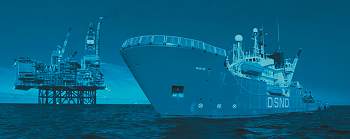 Editor John Bevan recently visited a selection of the top international underwater contractors based in Aberdeen. His mission: to profile the companies and evaluate the current and future trends in the offshore underwater industry. His tour included, among others, Stolt Offshore, Coflexip Stena Offshore, Halliburton Subsea, DSND Subsea, Oceaneering, and Fugro-UDI. This is his report. How are offshore subsea contractors faring in the current volatile international market? On the evidence of my whistle-stop tour, the picture is remarkably upbeat. The unanimous opinion of the companies concerned was highly optimistic. The negative trends sparked off by the sudden collapse of the oil price in late 1998 have already reversed and there is currently a high level of utilisation of assets. Some companies are predicting that next year they will not have enough hardware to meet their work potential. In one recent survey of companies in the UK North East, 42% reported increased exploration work, 62% forecast rising levels of production and service work, 53% were looking to recruit more people, and 62% expected increasing levels of overseas work. With Europe currently the world's largest offshore producer (438 fields producing some 6.5 million barrels of oil and some 20 billion cu ft of natural gas per day), this heralds good news for the offshore service and supply companies. So what is behind this reversal in fortunes and welcome upsurge in offshore activity? The most widely-held theory is that many of the major offshore operators, having experienced a period of mergers and internal restructuring and rationalisation, have been temporarily out of action. These mergers have included BP-Amoco, Total-Elf-Fina and Exxon-Mobil. But this year, after a slow start, it is business as usual. And, taken together with the embarrassingly high price of oil, an accelerating increase in activity is anticipated. To help get the ball rolling, the government lifted the moratorium on gas production from the UK Continental Shelf (UKCS) in February 2000. This immediately opened the door for further development of the gas fields. The UK government's spin-doctors have placed the UKCS on a Viagra-like treatment regime. Several initiatives have been launched to revitalise the sagging prospects of recent years. Under the auspices of the Department for Trade and Industry, led by the Secretary of State for Trade and Industry, Stephen Byers, an Oil and Gas Industry Task Force (OGITF, established in 1998) has identified a hit-list to initiate the second phase of development of the UKCS. A SECOND TASK FORCE was established in January 2000 to turn the proposals into reality. For details of the Task Force's activities see their dedicated web site at www.dti.gov.uk/ogitf The ambitious vision is to increase Britain's share of world oil and gas production by at least 50% over the next five years. This will require the UK to increase its exports by about £2 billion by the year 2005. By the year 2010 the Task Force wants:
The answer lies in the OGITF initiative which has spawned a family of related initiatives. An important one is the setting up of the PILOT Undeveloped Discoveries Workgroup. Its objective is to catalyse the joint development of discoveries by overlapping concession owners. There are a staggering 315 undeveloped discoveries on the UKCS alone! Among these, some 21 clusters exist. Two or three of these could even prove viable for development in the near term. Further information on PILOT can be obtained at webmaster@pilottaskforce.co.uk Bearing in mind that it takes roughly 18 months for exploration to be completed before construction can start, there will be an inevitable lead-time to serious construction activities. However, the offshore service companies have already begun to feel the ground-swell of the approaching mini-boom and are busy manoeuvring to capture their share of the growing market. Taken together with the race for the deep and ultra deep-water fields west of Shetland and in the 'golden triangle' delineated by the Gulf of Mexico, Brazil and West Africa, the future looks bright. Who better than the top international service companies based in Aberdeen to give an authoritative opinion on the present and future trends in the industry? Stolt Offshore is first to take the floor. |
© 2000 Underwater World Publications Ltd.
